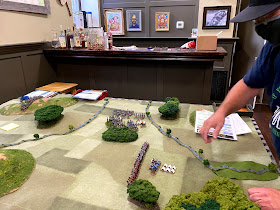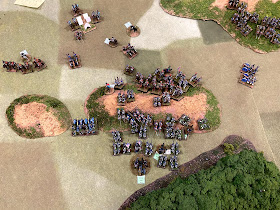Last monday we fought the third and likely final battle of the Tenesaw Gap from the NOLA Campaign. There are two turns left in the campaign and the French and the outcome is still to be determined. The NOLA campaign is my silly Napoleonic game that simulates a French invasion of America, which is defended by a combine US and British force. The battle was fairly even with 5 US and British divisions (4 Inf, 1 Cav) up against 5 French divisions (all infantry) plus the artillery reserve. We played the game using the ESR ruleset. The scenario had the pursuing French army catching up to the retreating US/British force. The French would enter on the left side of the map and all of the US/British forces are deployed.
Lannes enters with his single division on the far side of south western corner of the map
Ed begins shaking out his two British infantry divisions into line formation. I took command of the US Corp in the center of the picture. We placed the cavalry division in the center and planned to use it to support whichever flank had the most pressure.
My forces getting prepared to meet the french attack. Lannes continues to move against my flank as Davout's 2 divisions and the French artillery reserve enter the board and eye my positions menacingly.
Ed elects to defend a forward position as he hopes to switch to the attack if the opportunity presents itself.
Josh (Napoleon) deploys his artillery forward he is attempting to form a grand battery and if he can do within range of our forces it will be devastating. Artillery range is only nine inches in ESR (using 1" = 100M) but a grand battery can erase whole divisions at a time.
Seeing an opportunity the British cavalry charge forward trying to catch the artillery unprepared. They can not form the grand battery but the six batteries do get off individual fire and its enough to force the cavalry to break off the charge and retreat to lick their wounds- a golden opportunity lost
Lannes (Greg) forms into line for the attack as Davout (Dave) moves toward the hill
My 2nd division moved to occupy the woods (we removed the canopy) while the 1st division prepares to meet its French hosts on the reverse slope of the hill.
While the calvary recovers - Ed sees a gap in the line between Soults(Dave) corps and Davouts and elects to attack.
Lannes and Davouts attacks charge home - there will be seesaw fighting for 4 turns in the woods and on the hill
Josh can not bring his artillery reserve to bear and decides to move forward - the calvary see their chance and charge again - this time the french can only unlimber a few guns and the charge goes in devastating the limbered guns
Ed continues his attack. By the way it's a general rule of thumb in the club whenever Ed consults the rules during a turn it usually means something really bad is about to happen to your army.
Just as the cavalry charges the guns for a second time the fight in the woods is over as both divisions break at the same time.
With artillery dispatched, the British cavalry wheel and charge Davout's attacking division in the rear - caught between the cavalry and an American infantry division they are overwhelmed.
We called the game at this point as time was running out. It was declared a US/British victory and will have a major impact on the campaign.
































